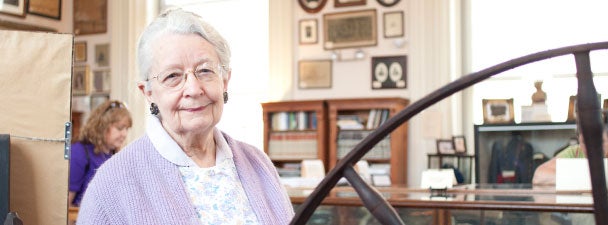Charleston is a city of postcard-perfect places, perhaps no locale more so than the city’s historic market, anchored on one end by its replica of the Temple of the Wingless Victory. Each day, tourists line up across Meeting Street, cameras and smart phones in hand, clicking snapshot after snapshot of this iconic Greek-inspired structure, and many visitors find the building’s double staircase, swathed in morning shade, a much-needed spot of respite from the Carolina sun and heat.
However, if they climb the 21 steps to its nearly 16-foot wooden doors, they will discover inside another Charleston treasure. No, it’s not the battle-scarred flag that flew over Fort Sumter or the life-size statue of Wade Hampton or even the small lock of hair from Robert E. Lee. Rather, it’s June Murray Wells ’56, executive director of the Confederate Museum.
She has been a fixture in the museum since 1952, when the Charleston native entered those creaking double doors for the first time as a College freshman. Like most students, then and now, she needed money to help pay for school. Wells, who worked part time as a lab technician at the Medical College (now MUSC), found a listing of scholarship opportunities in the back of a college catalog and applied for one.

“I guess it all began with that little scholarship,” smiles Wells, explaining that she went to the Confederate Museum to collect her $250 check from the Daughters of the Confederacy.
“When I came to pick up the check, the ladies of the museum had researched my family’s connections to the War Between the States and had pulled all these papers for me to see,” she remembers. “It was eye-opening in some regards. My family just didn’t talk about it, our Confederate heritage.”
That day, Wells had her first of many transformative history lessons. She learned that her grandfather worked for the Confederate Treasury, that one great-grandfather was a blockade runner, another served under Stonewall Jackson, and that a great uncle had signed the Ordinance of Secession.
“I was caught,” Wells laughs, thinking of these women in their wide-brimmed hats, veils, white gloves, high heels and pocket books just so. “I learned from them the stuff you don’t find in books.”
And the tales she heard from those ladies with the impeccable Charleston manners – including one of the city’s last surviving Confederate widows – kept her coming back for more. She loved learning the back stories of each of the 2,000 items the museum houses, such as the five-pound wooden-soled shoes worn by soldiers in Virginia snows or the variety of canteens (for both water and other spirits). It was history explained through everyday life. “In here,” Wells observes, “are the real things.”
Even after she graduated with degrees in French and biology and began a teaching career, she continued to volunteer at the museum and eventually inherited its directorship in the 1960s.
But don’t think of Wells as some docile docent. She’s not. There’s a fire behind those blue-gray eyes (perhaps more gray than blue) – a youthful spark of independence, tinged with a little bit of unrepentant Southern swagger. Unlike the objects in her museum, Wells is no relic. For decades, she has been at the center of both praise and controversy, from receiving the state’s highest citizen award, to her starring role as a Rebel charmer in Tony Horowitz’s Confederates in the Attic, to her advocacy for keeping the Confederate flag on the statehouse grounds in Columbia, when she was president-general of the United Daughters of the Confederacy.

No matter the topic on the Civil War, Wells feels a sense of duty to relate history in terms people can understand and to shed some of the conflict’s myths and glamour.
“I can’t tell you how many men died in each battle,” she confesses. And then, pointing to a pair of drumsticks taken from the corpse of a 12-year-old drummer boy on nearby Morris Island, she continues, “But I can tell you the personal stories. And maybe, just maybe, by showing people the reality of that war, the courage and sacrifice of the everyday person, we can actually teach peace.”
– Mark Berry
Photos by Gately Williams




